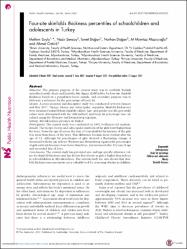Four-site skinfolds thickness percentiles of schoolchildren and adolescents in Turkey

View/
Access
info:eu-repo/semantics/openAccessDate
12.08.2021Author
Soylu, MeltemŞensoy, Nazlı
Doğan, İsmet
Doğan, Nurhan
Mazıcıoğlu, Mustafa Mümtaz
Öztürk, Ahmet
Metadata
Show full item recordCitation
Soylu, M., Şensoy, N., Doğan, İ., Doğan, N., Mazıcıoğlu, M. M., & Öztürk, A. (2021). Four-site skinfolds thickness percentiles of schoolchildren and adolescents in Turkey. Public health nutrition, 24(16), 5414-5425.Abstract
Objective: The primary purpose of the current study was to establish Turkish
smoothed centile charts and Lambda, Mu, Sigma (LMS) tables for four-site skinfold
thickness based on a population-based sample, and secondary purpose was to
elaborate a reference for the percentage of body fat.
Design: A cross-sectional and descriptive study was conducted between January
and May 2017. Triceps, biceps and subscapular, suprailiac skinfold thicknesses
were measured using Holtain skinfold caliper. Age- and gender-specific percentile
values were determined with the LMS method, and body fat percentage was calculated
using the Westrate and Deurenberg equation.
Setting: Afyonkarahisar province in Turkey.
Participants: The current study was conducted on 4565, 6–18-year-old students.
Results: The triceps, biceps and subscapular skinfolds of the girls were higher than
the boys. From the age of seven, the sum of four skinfold thicknesses of the girls
was more than those of the boys. This difference became more evident after the
age of 12. Although fat percentages of girls showed a fluctuating change, it
decreased with the age in boys. Westrate and Deurenberg equation fat percentages
of girls until adolescence were lower than boys, but increased after 12 years of age
and exceeded that of boys.
Conclusions: The current study has provided sex- and age-specific reference values
for skinfold thickness and has shown that obesity in girls is higher than in boys
in schoolchildren in Afyonkarahisar. The current study has also shown that skinfold
thickness measurements are a valuable tool for screening obesity in children.















